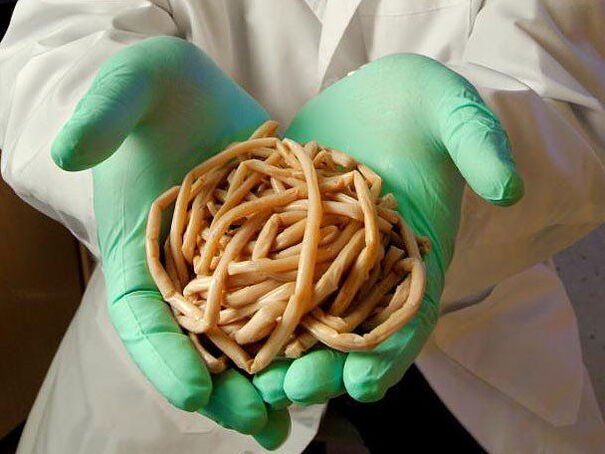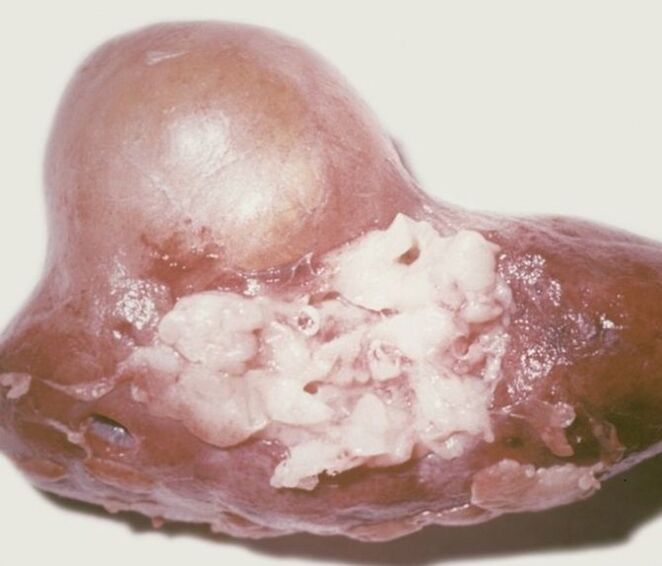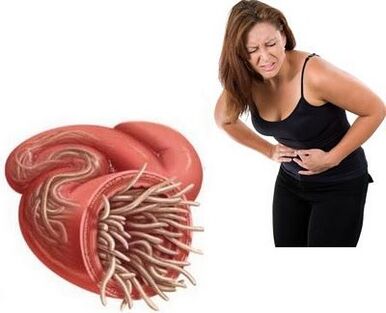Parasites - this is the name of one of the most common groups of infectious diseases.Today, about 300 parasites are known, which is a danger to humans, including deadly.In the European continent, these are just a few dozen parasites (medical names - helminthias, helminthic invasion).
The largest part of human-related parasites is common in countries with tropical and subtropical climate, as well as a low level of socioeconomic development and culture of hygiene.
What is a dangerous parasite

Parasites in the human body can affect almost any organ system.The degree of damage depends on the type of helminth, the duration of the disease, the early condition of health.The sooner the diagnosis of certain helminthic aggression is established, the more opportunities to quickly eliminate parasites.That is why it is important to diagnose the condition of the intrusion with timely parasites and to do all stages of treatment.
Almost any variation of helminthiasis, especially for a long time, causes significant harm to the human body.Hlybon invasion is a result of delay in psycho-motor development in children of all ages, significantly reducing performance and life reserves in adults.
Regardless of one's age, helminthic aggression contributes to allergies, reducing the immune system's ability to resist infectious diseases and others, in addition, the effectiveness of continuous vaccination prophylaxis is significantly reduced.
Cleaning of parasites in cases of spontaneous cases, in most cases, specialized treatment is required for this according to certain schemes.
What is a parasite

Parasites (they are also worms or worms) are a large group of organisms organized by multicellular complexes that can exist for a long time in active conditions in many cases.An important feature is the ability to exist in other living organisms (people or animals), called "aggression".
Currently, various types of parasites in the human body are known.The most common classification of parasites depends on their external structure and the features of the life cycle.
Given the characteristics of biological, all parasites are divided into 3 large classes:
- Round worms (they are also nematodes), for example, trichinella, ankylostoma, pin, ascaris;
- Ribbon worms (they are also cestods), for example, alveococcus, echinococcus, wide tape, cows -clinicals, pigs and dwarfs;
- Superers (they are also tremontods), for example, opistorch, fasciol, clonorch.
In addition, like many other diseases, parasitic diseases are different:
- by severity;
- by the leading syndrome, which is a damaged organ system to a larger level;
- with the presence and nature of complications;
- With the possibility of the outcome of the disease.
Features -The parasitic feature
Stage of development
Parasitic disease is characterized by some differences related to their parasitic features and their life cycle.
The number of adults in the human body does not increase, provided there is no new infection.For the implementation of the life cycle, most parasites require habitat (animal body, soil, etc.).
For any parasite, the development stage is typical.Throughout the life cycle, Helminth goes through several stages of development consistently.As a rule, parasitic eggs turn into larva and continue to be adult individuals.Reverse development does not occur, the eggs cannot go to the adult level immediately.
The parasite penetrates the human body at one stage of its life cycle, and goes outside.With this time that it is not a practical person of human parasitic disease.That is, it is impossible to be infected with the majority of parasitic diseases in direct contact with the infected person.
A possible penetration path into the human body
With many types of parasites, one can meet anywhere - they are not visible to the naked eye.The following options are most likely:
- Oral pathways, that is, with non -compliance with personal hygiene, the use of dirty products or unprocessed thermal;
- The percutaneous path, the larvae or adult parasite penetrates the human body through damage to the skin, when contacting water or soil, with the participation of blood -binding insects.
Most parasites that affect the human body live in it only in adulthood, especially in the digestive tract.This is a intestinal parasite called (helminths).They, in turn, are divided into 2 groups according to several features.
Intestinal parasites The first group enters the human body in the form of eggs.In the digestive tract, they turn into adult individuals.The movement of the parasites (pinworms, wide ribbons, pork and cow tape) is limited to different departments of the digestive tract.
Representatives of the second group (larvae or eggs) perform longer and complex migration according to various tissues and organs of the human body.Only after that adult parasite is formed.It is clear that the symptoms of parasitic diseases like this are much more diverse, as the migration process is associated with significant changes in the body.
Parasites, which are in adulthood or larvae located outside the digestive tract are called tissue.If in the human body parasite only exists at the larvae, then one for it is the end of the ecology, which the helmint cannot go.
Characteristics -Features of parasitic life cycles
To find out how to get rid of parasites in the body, it is necessary to represent their general life cycle.This knowledge also helps prevent parasites from entering the human body.
In accordance with the features of the life cycle, all parasites are divided into:
- Geo parasites;
- Infectious helminthoses;
- Bio helminthiasis.
To implement the Geo parasite life cycle (Vlasov, not Kore), it is necessary for eggs to be a certain period of time in the soil.In the future, with direct contact with dirty soil, inadequate use of vegetables, through dirty hands, parasites penetrate the human body.
In contagiosteal parasites (pinworms, dwarf tabbells), all stages of development only occur in the human body, without changes in the environment.Only a type of parasitic disease is transmitted directly from person to person.It is also possible, especially in the childhood, the cases of re -auto -Generations, that is, from yourself in terms of non -compliance with regulations and hygiene skills.
The most complex life cycle in adjusted biogelmintosis.The prerequisite for the implementation of their life cycle is the presence of the middle host.One can be either middle or last masters.For example, with echinococcosis, one is a mid -host, and dogs and cats are final.In the case of tusherinchosis, on the contrary, the representatives of the cattle are the middle host, and one is final.
Symptoms of parasites
The clinical signs of parasites, on the one hand, are determined by major damage to certain organs, on the contrary, they have general features that allow us to distinguish the level of acute and chronic parasites.
The acute phase of parasitic disease corresponds to the level of migration to develop helminths.It is characterized by clinical signs such as allergic and general toxic reactions (ascariasis, schistosomosis, fasciolesis, trichinellosis).
The immunological components have a significant weight in the development of acute parasitosis phase, forming certain stereotypes of the clinical picture and some similarities with other non -nonferive immunological reactions - drugs, allergic dermatitis and others.
The hidden period with most parasitosis is several weeks, reduced to 7-10 days with a massive version of the infection and extending with poor intensity.
The main symptoms of parasitic disease are as follows:
- Increase body temperature - from subfebrile to very high;
- pain in the muscles and joints, various duration and intensity;
- Formation of rash throughout the skin surface, vary in size and intensity, accompanied by itching -skin;
- Essential edema of the skin and subcutaneous tissue, less frequently - mucous membranes;The most typical for trichinellosis, which gives this disease a popular "swelling" feature;
- development of pulmonary syndrome, that is, night cough, astmitoid country, lung inflammation with a focus of transferring damage;
- development of stomach syndrome, characterized by moderate abdominal pain, fluid stools without mucus and blood;
- In severe cases, damage to the central nervous system and heart is observed;
- The distinctive features of helminthiasis are changes in peripheral blood: mentioned leukocytosis and significant eosinophilia (up to 30-40%).
In the treatment of the acute phase of the medicine from the parasites in the human body, most effective.
At the chronic phase of parasitic disease, the detrimental effects are determined by the type of adult parasite.The adverse effects on the human body are associated:
- larger and less allergic effects;
- mechanical damage to the tissues in the parasization zone (for example, liver echinococcosis);
- Nutrient absorption, infringement of metabolic processes, development of anemia and cachexia;
- severe anemia;
- Increased irritation and excitement of a person;
- It is possible to participate in secondary infections and dysbiosis, other disease of other diseases is contagious and endless, as well as pregnancy.
The duration of the existence of individual parasites is different - from a few days and weeks (cutters) to years.After parasitic disease, re -Kuman may, as immunity is not formed.Therefore, a body cleansing from parasites does not protect against recurrent episodes of the disease.
Parasitic treatment

Classical drug therapy of parasitosis today has achieved significant success.Introduction to clinical practice of benzimidazole and imidazole compounds enables to successfully treat various types of helminthias.
These drugs have a broad spectrum of exposure, small toxins with simple treatment, for adults and children are easy to use.The age that matches the dose of the drug should be noted.
How to clean a particular parasite body, which the treatment regimen to choose from and which medication is decided by the doctor.It is not recommended to prevent helminthiasis on personal initiatives, as addiction to drugs develops, which is a decrease in the effect.
Parasitic cleaning
With parasitosis, treatment with folk medicine is no less popular than traditional medicine.Supporters of natural tools for parasitic disease focus on the safety and university of the therapy.There are many traditional drug prescriptions, which allow you to effectively overcome parasites in the human body.The following options to eliminate parasites in the most famous human body:
- coriander and pumpkin seeds as prophylactic and therapeutic agents for parasites;
- Alcohol tincture on chanterelles is combined with white mushrooms;
- boil the pine cone;
- Tincture of Walnut Green.
Any people's remedies for parasites should be made by adhering to clean recipes and hands.Before choosing a specific recipe, it is important to make sure that one has no allergies to the ingredients that are part of the drug.
How to protect yourself from parasites

It's easy and difficult at the same time.Some simple rules will help minimize the risk of infection with any parasite:
- True -to wash your hands;
- Proper habits use individual sets of dishes;
- Thoroughly processing any meat and thermal fish, carefully using dried fish and meat;
- Treat the vegetables and fruits with boiling water (after washing water);
- Always wash your hands with soap after communicating with animals (though domestic).
Parasitic infections at any age are unpleasant problems, but completely eliminate early treatment.






































